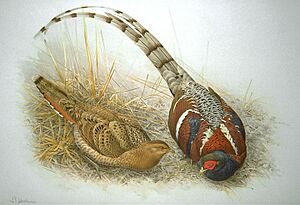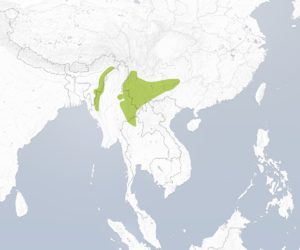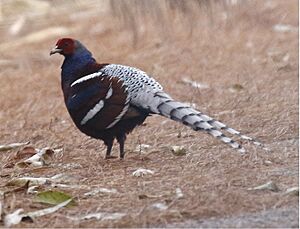Mrs. Hume's pheasant facts for kids
Quick facts for kids Mrs. Hume's pheasant |
|
|---|---|
 |
|
| Conservation status | |
| Scientific classification | |
| Genus: |
Syrmaticus
|
| Species: |
humiae
|
 |
|
The Mrs. Hume's pheasant (Syrmaticus humiae) is a beautiful bird. People also call it the Hume's pheasant or the bar-tailed pheasant. In some local languages, it has special names. For example, in Mizo, it is called Vavu. This large forest bird can grow up to 90 centimeters (about 3 feet) long.
Contents
About Mrs. Hume's Pheasant
Mrs. Hume's pheasant is a special type of pheasant. It lives in forests and has a unique look. This bird is known for its long, striking tail feathers. It is an important part of the ecosystems where it lives.
What Does It Look Like?
This pheasant has many colorful features.
- Its head is a greyish brown.
- It has bright red skin around its eyes.
- Its body feathers are a rich chestnut brown.
- It has a yellowish beak and brownish orange eyes.
- You can spot white bars on its wings.
- Its neck feathers are a shiny metallic blue.
The male pheasant is especially striking. It has a very long tail that is greyish white with black and brown stripes. The female bird is mostly chestnut brown. She has a whitish throat, a light brown belly, and a tail with white tips.
Where Does It Live?
This rare pheasant lives in forested areas. You can find it in parts of Mizoram, the Patkai Range, Manipur, and Yunnan. It also lives in northern parts of Myanmar and Thailand. These areas are its natural home.
What Does It Eat?
Mrs. Hume's pheasant mainly eats plants. Its diet includes different types of vegetation found in the forest. This helps it get the energy it needs to live and thrive.
Life Cycle and Reproduction
Female Mrs. Hume's pheasants lay their eggs in nests. These nests are often made from leaves, small branches, and feathers. A female can lay anywhere from three to twelve creamy white eggs. This is how new pheasants are born and the species continues.
Why Is It Special?
The Mrs. Hume's pheasant is named after Mary Ann Grindall Hume. She was the wife of Allan Octavian Hume, a British naturalist who studied nature in India. This bird is also very important to some regions. It is the official state bird of both Mizoram and Manipur in India.
Protecting This Bird
Sadly, Mrs. Hume's pheasant is facing challenges. It is considered a Near Threatened species by the IUCN Red List. This means it could become endangered if we don't protect it.
- Habitat Loss: Forests where these pheasants live are sometimes cut down or changed. This leaves the birds with less space to live.
- Fragmented Population: Their groups are spread out and separated. This makes it harder for them to find mates and grow their numbers.
- Hunting: Sometimes, these birds are hunted for food. This also reduces their population.
Because of these threats, Mrs. Hume's pheasant is also listed on Appendix I of CITES. CITES is an international agreement that helps control the trade of endangered animals and plants. This listing means it is highly protected from international trade. Protecting their homes and stopping illegal hunting are important steps to help these beautiful birds survive.



